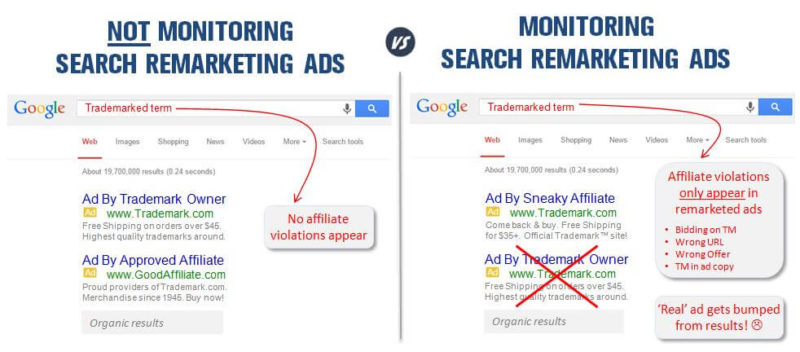4 Hidden Treasures In RLSA Campaigns
Contributor Lori Weiman shares some insights gleaned from analyzing thousands of remarketing ads over the course of several months.
Search remarketing ads, referred to by Google as Remarketing Lists for Search Ads (RLSA), allow advertisers to run a different AdWords campaign to people who have previously visited their site.
Advertisers can devote extra search marketing love to this incredibly valuable group by adjusting the group’s bids, ad copy, landing pages, and other campaign details. They can even choose a completely different keyword list to advertise on for this list.
It’s not just the advertisers who see dollar signs in building remarketing lists and communicating differently to them. Affiliates see the potential for much higher click and conversion rates from these golden lists.
While adding a remarketing campaign is a no-brainer for advertisers, what they (and their agencies) haven’t realized yet is that these remarketing ads are a treasure trove of insights that marketers can use, and they should be monitored very closely.
What exactly is the treasure buried within? Below are four gems The Search Monitor (my employer) found after pointing its ad crawling technology towards thousands of remarketing ads since January 2015.
1. Affiliates Behaving Badly
The first piece of remarketing gold we discovered concerns how certain enterprising affiliates are using remarketing. Since only searchers who were previously “cookied” on a website see search remarketing ads, they’re much harder for an advertiser to monitor through manual or automated searches.
This clandestine nature of remarketing ads makes them the perfect location for affiliate marketers to bend (or outright break) their advertiser’s rules. Let’s see how an affiliate would pull this off.
The example below shows an affiliate that decided to modify its advertising behavior in remarketing ads only. By the way, in this context, “affiliates” refers to any partner (e.g., a re-seller) that advertises on your behalf and has agreed to a specific set of advertising behaviors.
This example shows how the affiliate obeyed their advertiser’s rules perfectly in non-remarketed ads, but then unleashed a torrent of violations for searchers that were on the affiliate’s remarketing list.
Specifically, the example shows the following all-too-common violations:
- Bidding on restricted keywords or trademarks
- Using trademark and TM-plus terms in ad copy
- Outranking the advertiser
- URL hijacking, an all-too-common practice that bumps you out of search results and raises your cost-per-sale
Do these happen often? Yes!
Why do they happen? Often times, it’s a purposeful act by the affiliate who knows they can generate more clicks and sale commissions if they bid on the most lucrative keywords with the most compelling ad copy (i.e., using a prohibited trademark). Couple this monetary incentive with a belief they won’t get caught, and you get an easy recipe for rule-breaking.
On some occasions, however, the act can be unintentional. Perhaps the affiliate set up a remarketing campaign more recently than their regular campaigns and failed to check the latest program rules posted by their advertiser. They believe they are in full compliance but continue breaking the rules — in ignorant bliss — until they are reprimanded.
Whether intentional or not, few advertisers monitor remarketing ads to identify such violations. And while Google does not want its advertisers to violate trademark usage, it does not actively monitor these violations, let alone tell advertisers to change their ways. It falls on vigilant advertisers to detect and report infringements on their trademarks.
2. Competitors Behaving Badly
The same scenario described above can happen with your competitors. They know very well that remarketing ads are tricky to police. And, they understand that they should not be bidding on an advertiser’s trademarks or using them in their own ad copy.
The lack of monitoring combined with an opportunity for more clicks is a match made in heaven for certain competitors, unfortunately.
Here’s what it would look like:
Just like with affiliates behaving badly above, there is no incentive for them to stop if they think they can’t be caught. Once you do catch them, however, it becomes much more likely that either they or the search engines will take down the offending ads.
3. Competitors To Copy
The third nugget of treasure gathered from remarketing surveillance comes in the form of competitive intelligence. With any new marketing tactic, it pays to study who’s using it currently and look at exactly how they’ve implemented their campaigns for success.
Closely monitoring remarketing ads of competitors and industry leaders helps advertisers in two ways:
First, if you’re currently not running any search remarketing, you can easily find out the percentage of your competitors who are. If competitors engage in search remarketing (and you don’t), this is incredibly powerful data to convince the powers that be that it’s time to launch remarketing campaigns to remain competitive.
Second, if you’re already running remarketing campaigns, monitoring these ads regularly can quickly reveal a few best practices from your industry. There’s always something to learn from competitors that an advertiser can easily A/B test in their own campaigns.
Offers are an easy place to start. Knowing which offers are served up to remarketing lists, and how strong these discounts are, helps an advertiser plan an effective competitive counter-attack.
Take the example below. It shows how an advertiser’s competitor drops their prices by $20 on certain products, but only in their remarketed ads.
Landing pages are another best practice to gather through competitive remarketing surveillance. Imagine how your strategy would change if you learned that competitors sent their remarketing list members to a special landing page with different messaging and a much richer offer.
Monitoring remarketing campaigns can also reveal your competitors’ unique geo-targeting strategies. You may learn, for example, that most of your competitors are only running remarketing ads in geographies where they are trying to gain market share or have physical stores, and this can impact which geographies you focus on.
4. SEM Business Development Opportunities
The last treasure hidden in remarketing ads is the opportunity to drum up new business for your agency. The biz dev team is always on the lookout for potential clients who aren’t taking advantage of the latest in PPC tactics, and remarketing campaigns is an obvious one to promote to leads.
Grab your nearest business development colleague, and share these two tips with them:
- Generate a list of advertisers not currently using search remarketing. Market to them about the benefits of search remarketing and offer them your search remarketing services. Specifically mention how you monitor these campaigns, understand best practices, and can easily apply them to a new program that, conveniently, you will run for them.
- Generate a list of advertisers already using search remarketing and tell them how you can improve their current performance by monitoring their competitors’ ad copy and landing pages (to remain competitive) and their industry leaders (to learn best practices). Since monitoring search remarketing in an automated, comprehensive way is a fairly complex task, they should be receptive to the offer.
The title page of these two pitch decks might look like this:
If nothing else, gathering intel on search remarketing gives you a reason to start a productive conversation with potential clients.
Uncovering PPC Treasure
You’ve seen how remarketing ads provide a rich treasure chest of valuable insights for the search marketer. After just a little digging, it’s easy to find affiliates behaving badly, competitors and industry leaders to learn from, and even opportunities for winning new business.
Knowledge is power, so keep a close eye on this exciting new branch of search marketing and you’ll be pleasantly surprised by the gems you discover.
Contributing authors are invited to create content for Search Engine Land and are chosen for their expertise and contribution to the search community. Our contributors work under the oversight of the editorial staff and contributions are checked for quality and relevance to our readers. The opinions they express are their own.
Related stories




